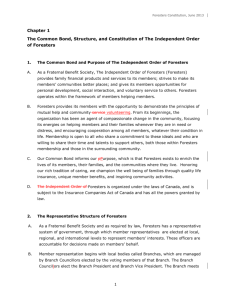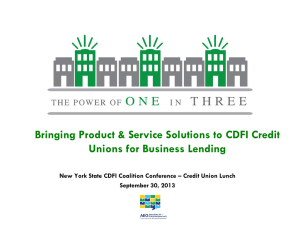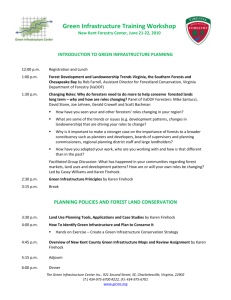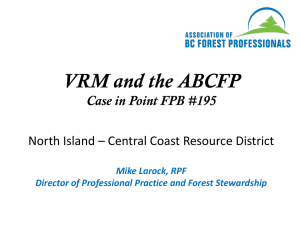Foresters Community Finance
advertisement
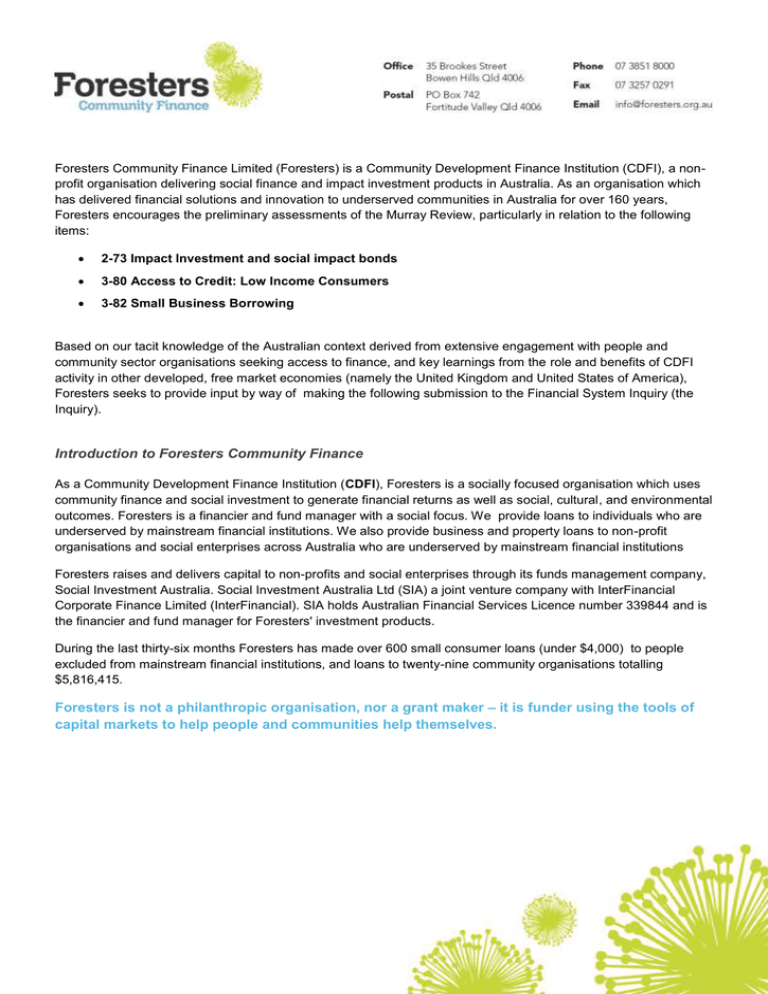
Foresters Community Finance Limited (Foresters) is a Community Development Finance Institution (CDFI), a nonprofit organisation delivering social finance and impact investment products in Australia. As an organisation which has delivered financial solutions and innovation to underserved communities in Australia for over 160 years, Foresters encourages the preliminary assessments of the Murray Review, particularly in relation to the following items: 2-73 Impact Investment and social impact bonds 3-80 Access to Credit: Low Income Consumers 3-82 Small Business Borrowing Based on our tacit knowledge of the Australian context derived from extensive engagement with people and community sector organisations seeking access to finance, and key learnings from the role and benefits of CDFI activity in other developed, free market economies (namely the United Kingdom and United States of America), Foresters seeks to provide input by way of making the following submission to the Financial System Inquiry (the Inquiry). Introduction to Foresters Community Finance As a Community Development Finance Institution (CDFI), Foresters is a socially focused organisation which uses community finance and social investment to generate financial returns as well as social, cultural, and environmental outcomes. Foresters is a financier and fund manager with a social focus. We provide loans to individuals who are underserved by mainstream financial institutions. We also provide business and property loans to non-profit organisations and social enterprises across Australia who are underserved by mainstream financial institutions Foresters raises and delivers capital to non-profits and social enterprises through its funds management company, Social Investment Australia. Social Investment Australia Ltd (SIA) a joint venture company with InterFinancial Corporate Finance Limited (InterFinancial). SIA holds Australian Financial Services Licence number 339844 and is the financier and fund manager for Foresters' investment products. During the last thirty-six months Foresters has made over 600 small consumer loans (under $4,000) to people excluded from mainstream financial institutions, and loans to twenty-nine community organisations totalling $5,816,415. Foresters is not a philanthropic organisation, nor a grant maker – it is funder using the tools of capital markets to help people and communities help themselves. 2-73 Impact Investment and Social Impact Bonds Policy Option: No change to current arrangements Foresters believes that no change to current arrangements will result in a significant opportunity cost to the development of an emerging sector in Australia, which supports efficiency, innovation and growth of the Australian non-profit sector. Foresters believes that whilst progress has been made to make capital available to social enterprises and nonprofits seeking to grow and develop their services/and or entrepreneurial activity, there are significant opportunities to scale the sector’s capacity to innovate, through the provision of targeted support to specialist financial intermediaries in Australia. Currently, specialist financial intermediaries, tailor their activities to support the non-profit sector by improving access to an alternate source of capital, resulting in some non-profits and social enterprises adopting more innovative funding models. These intermediaries do not just provide capital to non-profits and social enterprises, but actively work with them through each step of the financing process. There are only a few financial intermediaries in Australia which specialise in providing community development finance to either individuals and community organisations. Foresters like other specialist finance intermediaries in Australia, sources investment capital from institutional investors, individuals, philanthropic foundations, and has received government funding for service delivery. In agreement with the Productivity Commission 2010 Report into the Contribution of the Not-for-Profit Sector, Foresters has identified the main barriers to non-profits and social enterprises accessing capital from impact investment are: the lack of collateral to guarantee loans resulting in a higher LVR, which often exceeds the credit criteria of mainstream lenders Information asymmetries: A lack of knowledge and awareness of alternative sources of capital for nonprofit organisations and social enterprises High level of transaction costs required to deliver relatively small amounts of capital into the market The lack of a suitable organisational structure which would allow organisations to raise equity capital. Many social enterprises, struggle between choosing a structure which facilitates the use of equity to grow, however the required organisational structure may exclude access to grants and philanthropic capital 1. In addressing such market failures, specialist finance intermediaries support the non-profit sector to grow and develop through access to affordable and tailored finance. However, similar to UK context as reported by CDFA2, many intermediaries are under capitalised and are too small to succeed, and are restricted in their capacity to make an impact. 1 2 Source: Qrtr 1 2014 Bulletin, CDFA cdfa.org.uk Productivity Commission: Report on the Contribution of the Not-for-Profit Sector, 2010 There is little doubt that the role Government played to date, in catalysing the Australian impact investment market through the $20m Social Enterprise Development Investment Funds (SEDIF) initiative (established late in 2010) has been successful, although relatively small in scale. In Foresters case, the $6m was matched by $6m in institutional investment which with the assistance of operational funding, enabled Foresters to achieve the following over the last 3 years: Investments totalling $5,816,415 in twenty-six (26) social enterprises in Australia Capacity building workshops to more than 1,300 individual organisations Take over nine hundred (900) direct enquiries for community finance Provide referral to expert consultants for organisational change and provide a direct corporate advisory service to non-profits and social enterprises on social enterprise feasibility, financial capacity and strategy for raising capital Foresters believes that a major constraint on capital access arises because the market which specialises in providing both finance and other support to the non-profit sector is itself underdeveloped. As such, the development of a robust capital market for the non-profit sector should be a priority. Additionally, without key legislative supports for CDFIs in Australia as there are in other countries, there is reduced capacity for the delivery of impact investment initiatives to finance non-profit sector innovation and find new ways to deliver essential services. Policy Option: Provide guidance to superannuation and philanthropic trustees on impact investment. Foresters advocates Government provide guidance to superannuation and philanthropic trustees by explaining how they can make impact investments within the existing regulatory framework. Additionally, Foresters sees a need for the development of guidelines and education initiatives to guide philanthropic trustees on the pros and cons associated with making impact investments. The Inquiry has identified that some superannuation trustees consider their fiduciary duties to be a barrier to impact investment. This is despite there being no explicit prohibition to impact investment provided, superannuation trustees meet the sole purpose test. In their recent report, March 2014, the University of Sydney3 agreed with this saying, ‘… At a more fundamental level, charitable trusts and foundations seek comfort that impact investment, with its ‘soft’ and ‘non-financial’ benefits, will not compromise the investment duties with which they must comply under statute and general law”. Foresters believes that it will take the collective and focused effort of diverse stakeholders to realise the opportunities presented by impact investment. All stakeholders – investors, intermediaries, government and impact enterprises – must work together to build a pipeline of opportunities that can be translated into investable product. Meanwhile, investors must secure the commitment of trustees and senior management to include impact investment in their impact toolkit. A guideline to impact investing and further efforts to continue to educate 3 Impact Investments - Perspectives for Australian Charitable Trusts and Foundations – March 2014 philanthropic trustees on the value of investing their corpus into impact investment will assist in developing the pipeline of available capital to non-profits and social enterprises seeking to innovate. Once again, Australian CDFIs are poorly resourced to lead such am initiative. Policy Option: Classify a private ancillary fund as a sophisticated or professional investor for the purposes of the exemptions from the prospectus regime if the sponsor of the fund meets either of these thresholds. Foresters considers that classifying a private ancillary fund as a sophisticated or professional investor for the purposes of the exemptions from the prospectus regime will deepen the pool of potential impact investors. Foresters, through its funds management arm, Social Investment Australia Ltd, has engaged Private Ancillary Funds in investment and believes impact investment is a key opportunity for PAFs to earn a financial return and make a social impact. Continuing to exclude such entities from engaging in impact investment where they are established by individuals and organisations which meet the criteria for being a sophisticated investor will inhibit growth of the impact investment market in Australia. Policy Option: Simplify and streamline disclosure requirements associated with social impact bonds. Foresters supports streamlining disclosure requirements associated with social impact bonds, Policy Option: Undertake a more active role in expanding impact investment, such as providing risk capital and establishing social investment banks. Foresters believes there is a need, in Australia, for a wholesale capital fund from which CDFIs could access funding that is then supplied to social enterprises and not-for-profits. Governments may increase capital to the sector by establishing a capital fund, as has been done in the US, and with the likes of Big Society Capital in the UK. In the UK, dormant bank and building society account monies are collected, by the Reclaim Fund, and the English monies are provided to Big Society Capital. This, Big Society Capital says, ‘…To have a transformative impact on the social investment market in the UK by supporting social investment finance intermediaries to become financially robust and able to: Attract greater and more diverse sources of investment Effectively and efficiently channel appropriate and affordable capital to the social sector; and Provide effective financial and business support services to the social sector…’. 4 Governments could also encourage the major banks to contribute to this capital fund. Again in the UK, the four main UK high street banks have each contributed additional capital in aggregate equivalent to 60% of the amount provided by the Reclaim Fund. This represents an equity investment. The banks’ contribution is limited to specific amount over five years. 4 http://www.bigsocietycapital.com/about-big-society-capital The capital fund would act as a wholesale fund from which CDFIs can borrow. Foresters believes there is a need to invest in CDFIs and specialist financial intermediaries to secure the long term viability of impact investment in Australia. A pertinent international example concerning the development of legislation and policy relating to catalysing CDFI activity, is the United States of America. The US CDFI Fund was established in 1994 by the Riegle Community Development and Regulatory Improvement Act. This was a bipartisan initiative, approved by both Democratic and Republican leaders at the time. The fund operates with the mission to promote access to capital and create localised economic growth in partnership with CDFIs through (but not limited to) the following mechanisms: Capacity Building: Direct investment, training and support to CDFIs who provide loans, investments, financial services and technical support to underserved people and community organisations Bond Guarantee: Establishment and ongoing operation of CDFI Bond Guarantee Program which issues bonds to support CDFIS to make investments for eligible community or other development initiatives. Issues of bonds to support CDFIs to invest in line with their vision and mission/delivery of tax credits The United States Treasury states: “Since its creation, the CDFI Fund has awarded over $1.7 billion to community development organizations and financial institutions; it has awarded allocations of New Markets Tax Credits which will attract private-sector investments totalling $33 billion, including $1 billion of special allocation authority to be used for the recovery and redevelopment of the Gulf Opportunity Zone”5. Foresters believes the development of a capital fund combined with appropriate publicity, and direct investment in CDFIs would considerably enhance the knowledge of the sector, and enhance the capacity of CDFIs to deliver investment The SEDIF has catalysed $20m of impact investment capital to contribute to the development of the Australian social enterprise sector. However, the 3 organisations which received funding are sub-scale and do not have the size and operating budgets to appropriately reach and satisfy the market. The capital source and organisational structures to successfully provide funding for the long-term needs a further catalyst. As mentioned previously, CDFIs do not just provide capital to non-profits and social enterprises, but actively engage in a process of capacity building with each organisation during the loan process. Capacity building includes assessment and feedback on business proposition, suggestions regarding governance, operations, strategy and financial performance, and in some cases additional consultancy services are provided. Capability and capacity building necessary to deliver finance to underserved non-profits and social enterprises, means a longer and more intense engagement is pre-requisite to securing an investment. This extended 5 Source: www.CDFIfund.gov transaction time is not covered by the normal returns associated with lending to enable the lending to remain competitive. CDFIs are therefore at a competitive disadvantage to the mainstream financiers who typically supply the larger social enterprises and non- -profits and will typically benefit from the service provided by the CDFIs as the CDFI client becomes bankable and ‘graduates’ to mainstream banks. 3-80 Access to Credit: Low Income Consumers Policy Question: Is there a role for Government and/or industry to facilitate further development of microfinance initiatives, in collaboration with the not-for-profit and community sector? Foresters advocates that there is benefit in expanding the roles for both Government and industry to facilitate further development of integrated microfinance initiatives in Australia. Foresters believes Government could expand its role in facilitating further development of integrated support and service delivery for people experiencing financial exclusion in Australia by way of further support to CDFIs in creating financial resilience prior to people reaching crisis point. Government may also seek to review Responsible Lending Guidelines to incorporate an assessment on the broader requirements and objectives associated with a loan application. Foresters is currently funded by the Department of Social Services’ CDFI Pilot Program to delivery small consumer credit facilities to people who cannot access mainstream finance. In our experience, in delivering microcredit to excluded people in South East Queensland and Melbourne (through a key partnership with a Customer Owned Bank), is that people who are seeking alternate forms of capital need access to the best options. Government funds financial counsellors who manage crisis situations, however there is demonstrated need to fund capacity building before people are in major crisis, particularly concerning understanding their financial position as a pathway to financial resilience. The microfinance unit in Foresters takes on average, two thousand enquiries per annum. On these enquiries, only 8% are converted to loan outcomes. The majority of enquiries involve a conversation around money management and recommendations on better options, such as negotiating payment arrangements with a utility supplier, lifestyle adjustments, or seeking financial counselling services. Enquiries to a financial services provider present a key opportunity, where community organisations may engage and support people prior to their financial circumstances reaching crisis point. CDFIs’ role is to support people in a “beyond lending” or “not just a loan”. Fringe lenders are in the business of making loans and will only offer loan solutions. Foresters argues that people who are experiencing financial exclusion need support to understand all options available to them, and referrals to appropriate services. Recent comments by ASIC deputy chair Peter Kell (May 2014) 6 outlines that not enough enquiries about the “broader requirements and objectives” of loans is included within most responsible lending processes. Foresters, as a mission driven CDFI, takes this into account and will direct customers to the range of best options that may not include a loan. For example a customer seeking funds to pay an utility account will be encouraged and 6 Peter Kell, ASIC, Consumer credit regulatory update 2014, 14 May 2014 coached into how to negotiate a interest free payment arrangement with the supplier, rather than just be provided with the funds based on only the ability to repay, rather that their overall objective and position. Another pertinent example includes clients who are seeking to purchase white goods who would be eligible to access a no interest loan under the NILS program. From Foresters’ experience, the NCCP enhancements have put sensible caps on total repaid (twice loaned), caps on costs in the SACCS “20 + 4” and 48% actual real costs on medium amount loans – this has lead to a much better regulated industry, with only few loopholes still being exploited. The resulting rationalisation of the fringe lender market has meant that local providers, have been replaced by larger lenders, who do not possess the same relationships with their customer base, and understanding of the ‘best option’. Foresters advocates that industry, namely mainstream financial institutions seek to refer where possible, declined credit applications to CDFIs and other community organisations providing microfinance and financial literacy support services. Increasing the ties and referral relationships between mainstream financial institutions and community organisations will allow for people who cannot access mainstream credit, apply for loans with a community organisation, concerned with increasing their financial resilience, and participation. Foresters currently works with BankMECU in the delivery of alternative credit to people who cannot access loans from their branch in Fitzroy, Melbourne. This one agreement, established for 1 year, has already resulted in fortysix loan outcomes for people otherwise excluded from mainstream financial services/products. The development of additional relationships between community organisations, specialist finance intermediaries, and mainstream financial institutions will serve to increase the capacity of intermediaries to deliver options to the 3m financially excluded people in Australia. Policy Question: To what extent would this improve access to small amount credit? The Inquiry Report notes that while there is some activity by community organisations, these schemes provide a very small supply of reasonably priced fringe credit compared to overall demand estimated at in excess of $380 million. Foresters believes that both expanding government and industry’s role in the provision of credit to excluded people, will increase this figure, by way of expanding community organisations and CDFIs’ geographical reach, capacity to provide intervention and crisis prevention services and suitable credit options. The market in which community organisations can deliver these services and products is considerable, given this year’s7 NAB/CSI Report on Financial Exclusion shows that 16.9% of the adult population (18+) in Australia were either fully excluded or severely excluded from financial services in 2013. In real terms, close to 3m adults are excluded. Connolly C, Measuring Financial Exclusion in Australia, Centre for Social Impact (CSI) – University of New South Wales, 2014, for National Australia Bank. 7 3-82 Small Business Borrowing Foresters advocates that industry, government and specialist finance intermediaries explore the scope to develop initiatives similar to that of SEDIF, to catalyse appropriate investment in SMEs operating in Australia. Foresters believes there is significant scope for CDFIs to facilitate access to credit by SMEs in Australia. The primary activity for several CDFIs in both the UK and US contexts consists of lending to small to medium enterprises to create local economic development outcomes, such as employment in communities. Foresters’ experience in working with social businesses as part of the Department of Employment’s SEDIF initiative, has contributed to an understanding that affordable and appropriate capital made available to local businesses, will help to grow and develop the SME market in Australia. The activity of CDFIs internationally, speak to this hypothesis. The CDFA (Community Development Finance Association), reported that in Quarter 1 2014, the overwhelming majority of investments by CDFIs in the UK was to small to medium enterprises. CDFIs In total, in the first three months of the year, invested 23.5million pounds in 2,071 SMEs.



